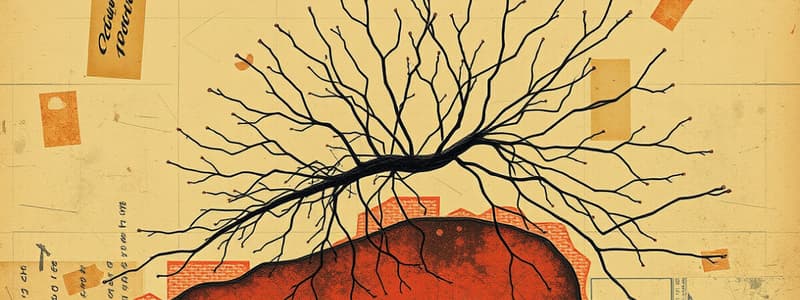Podcast
Questions and Answers
What level of organization is the small intestine?
What level of organization is the small intestine?
- Organ system
- Tissue
- Organ (correct)
- Cell
Which of the following statements about colonial organisms is correct?
Which of the following statements about colonial organisms is correct?
- They can survive when separated.
- They are multicellular. (correct)
- Their cell activities are integrated.
- They are a collection of different kinds of cells.
Cell membrane is to cell as _____ is to house.
Cell membrane is to cell as _____ is to house.
- Window
- Door (correct)
- Wall
- Roof
Which type of molecule forms the cell membrane?
Which type of molecule forms the cell membrane?
Phospholipids are molecules that have _____.
Phospholipids are molecules that have _____.
What is the function of microfilaments in a cell?
What is the function of microfilaments in a cell?
Which organelle is primarily responsible for modifying and packaging proteins?
Which organelle is primarily responsible for modifying and packaging proteins?
Where in the cell are ribosomes that produce proteins for export located?
Where in the cell are ribosomes that produce proteins for export located?
What organelle contains enzymes for digestion in plant and animal cells?
What organelle contains enzymes for digestion in plant and animal cells?
What term refers to the double membrane that surrounds the nucleus?
What term refers to the double membrane that surrounds the nucleus?
In which cell type would you find chloroplasts?
In which cell type would you find chloroplasts?
What is the main role of mitochondria in the cell?
What is the main role of mitochondria in the cell?
Which of the following structures is unique to prokaryotic cells?
Which of the following structures is unique to prokaryotic cells?
Study Notes
Cytoskeleton and Cell Structure
- Cytoskeleton consists of three types of protein fibers: microfilaments, microtubules, and intermediate fibers.
- Microfilaments assist cells in changing shape and fitting into tight spaces.
- Microtubules are involved in providing structure and transport within cells.
Genetic Material and Ribosomes
- DNA and certain proteins are synthesized in the nucleus and by ribosomes, respectively.
- DNA must be kept separate from the cytoplasm, while proteins are produced inside the ribosomes that may be associated with membranes.
Nucleus and Organelles
- The double membrane surrounding the nucleus is known as the nuclear envelope.
- Ribosomes produce proteins in a cell; they may be either free or bound to other organelles.
- Bound ribosomes are attached to membrane structures within the cell.
Endoplasmic Reticulum and Golgi Apparatus
- The endoplasmic reticulum moves proteins and other substances through the cell, while the Golgi apparatus modifies, sorts, and packages proteins for distribution.
Plant Cell Structures
- Plant cells contain a large central vacuole for storage of water, waste, and nutrients, distinguished from organelles like mitochondria and chloroplasts.
- Mitochondria are energy-producing organelles, whereas chloroplasts are responsible for photosynthesis.
Comparisons of Organelles
- Both chloroplasts and mitochondria are involved in energy processes, with mitochondria focusing on ATP production.
- Mitochondria are found in both plant and animal cells, while a cell wall is unique to plant cells.
Prokaryotic vs Eukaryotic Cells
- Pili are short, thick outgrowths that allow prokaryotic cells to adhere to surfaces or each other.
- Bacteria serve as an example of prokaryotic cells, contrasting with complex eukaryotic cells like muscle cells or fungi.
Levels of Biological Organization
- The small intestine is classified as an organ, indicating a higher level of organizational complexity within biological systems.
- Colonial organisms consist of individual cells that can survive independently, signaling a level of integration without being multicellular.
Cell Membrane Composition
- Cell membranes are primarily composed of phospholipids, which have a characteristic structure of one polar phosphate head and two nonpolar fatty acid tails, crucial for membrane function.
Studying That Suits You
Use AI to generate personalized quizzes and flashcards to suit your learning preferences.





